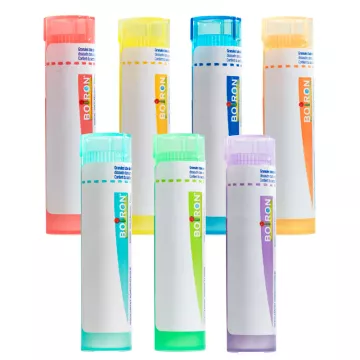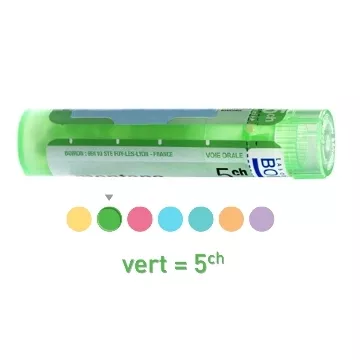

Discomfort, pain, itching or bleeding... Hemorrhoids can become a real handicap in everyday life. On Soin-et-Nature, you'll find a selection of targeted homeopathic treatments to gently soothe anal zone disorders, without harming the body. Based on recognized strains such as Hamamelis, Paeonia or Nux vomica, these natural remedies help reduce inflammation and symptoms while respecting the balance of the hemorrhoidal plexus.
Hemorrhoids have always been a common ailment that can affect anyone, but especially adults, especially pregnant women and the elderly. Hemorrhoidal attacks manifest themselves as itching, unbearable pain and sometimes even bleeding of varying severity, depending on the case. There are numerous treatment options, from topical creams to surgical intervention, depending on the severity of the attack. But there's another solution: homeopathy. It's both natural and effective.
In their normal state, hemorrhoids are painless venous formations around and inside the anus and rectum. Problems arise when a hemorrhoidal crisis occurs, caused by abnormal dilation of these veins. These vessels can then protrude to form a "ball" in the anus.
Symptoms are occasional and easily recognized: itching near the anus, discomfort when sitting and bleeding when having a bowel movement.
Anti-hemorrhoidal treatments aim to relieve pain and reduce inflammation, which plays an important role in hemorrhoidal flare-ups.
Hemorrhoids are varicose veins of the anal and rectal mucosa. A distinction is made between internal hemorrhoids, visible by anoscopy, and external hemorrhoids, which protrude from the edge of the anus. Depending on their severity, there are several ways to relieve or even eliminate hemorrhoids. The first concerns dietary hygiene: eat plenty of fiber-containing foods (vegetables and fruit) and avoid foods such as spices, alcohol and coffee.
Hemorrhoids are, in short, a dilation of the vessels of the hemorrhoidal plexus in the anal canal. Symptoms include irritation and bleeding. Thrombosed hemorrhoids are usually painful.
The hemorrhoidal pad consists of an arteriovenous vascular complex fed from the superior rectal artery by the superior and middle hemorrhoidal arteries. Drainage is via the hemorrhoidal veins, which circulate through the sphincter apparatus. The hemorrhoidal pads are consequently covered with mucous membrane, and lie in a thick submucous layer of connective tissue and smooth muscle cells above the pectineal line (cavernous body of the rectum).
They are held in position by connective tissue fibers that exert traction towards the internal anal sphincter muscle. Hemorrhoids occur when the vascular cushion is more developed than normal. The typical locations of hemorrhoids are indicated at 3, 7 and 11 o'clock in the lithotomy position, although there is considerable variability between individuals. They can be distinguished from the rectal mucosa by their more purplish color.
The postulated cause of enlarged hemorrhoids is venous congestion, with consequent hyperplasia of the rectal corpus cavernosum and slippage of tissue into the anal canal. Increased resting tone of the sphincter and prolapse of the hemorrhoidal plexus may be responsible for the disturbed venous outflow. Loss of function of the suspensory ligament around and above the arteriovenous vascular complex, consisting of muscular and elastic connective tissue fibers, associated with subsequent mucosal descent, may be an independent causative factor.
New morphological and hemodynamic assessments of the anorectal vascular plexus have also shown that the vascular convolutions have an intrinsic contraction mechanism consisting of smooth muscle cells, which regulate the supply and removal of blood volume as well as its flow velocity within the vessels. Destruction of this regulatory system, with muscle cells replaced by connective tissue fibers, leads to the formation of hemorrhoids. The composition of collagen also seems to play a role; studies have shown an increase in matrix metalloproteinases within collagen.
It is easy to imagine that mechanical irritation (e.g. from diarrhoea, hard stools or handling) or increased intra-abdominal pressure (as in pregnancy, visceral adiposity, ascites, etc.) influence these pathophysiological mechanisms, but these have not been proven to be the cause.
The physiological role of the vascular cushion is to guarantee fecal continence, in collaboration with the sphincter apparatus. The juxtaposition of mucosal folds makes the anal canal impermeable to liquid fecal matter and air. This ensures 15-20% of continence.
It's important to distinguish between "internal" hemorrhoids and what used to be called "external" hemorrhoids (now called perianal veins), formed by a subcutaneous perianal vascular plexus covered by skin.
For internal hemorrhoids, the doctor may therefore use photocoagulation of the hemorrhoidal zones, or liquid nitrogen. Internal hemorrhoids generally manifest themselves as bleeding after defecation; blood can be seen on paper and sometimes in the toilet bowl. Internal hemorrhoids can be uncomfortable, but are not as painful as thrombosed external hemorrhoids. They sometimes lead to mucus discharge and feelings of incomplete evacuation.
For external hemorrhoids, several methods are still in use: elastic ligation, which devitalizes the hemorrhoids; photocoagulation; and injection of sclerosing products directly into the hemorrhoids (4 to 6 successive injections - good results). The latter technique is also known as sclerotherapy. External hemorrhoids can thrombose, causing painful purplish swelling. Rarely, they may ulcerate, causing a small hemorrhage. Cleansing the anal area can be difficult.
One of the most effective natural treatments is homeopathy. As well as being easy to use, it exposes you to no risk of side effects. When a hemorrhoidal crisis occurs, take immediate steps to limit complications. You can opt for one of the following homeopathic solutions:
Discover our new range of homeopathic medicines to effectively treat your hemorrhoid problems with homeopathy.